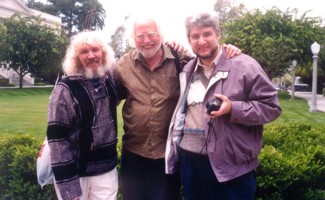Mht. det sorte har du helt ret i at det skyldes høsttidspunktet, det er sporer. For så vidt blåning, så har det ikke så meget at gøre med høsttidspunktet, men er en reaktion, der først og fremmest sker når svampene bliver udsat for lidt vold. Hvis jeg må citere mit forsøg for et par dage siden på at citere fra en af de højeste autoriteter indenfor psilocybinologien, Dr. Jochen Gartz.

I selskab med Dr. Shulgin i midten og "Mushroom John" Allen t.v.
From what I can make of Gartz'
Magic mushrooms around the world, chapter 5
----------------------------
Psilocin is unstable in the presence of oxidizing agents [air], and "solutions of psilocin turns bluish-green in an alkaline range." Psilocybin does not turn blue because "it is protected by the phosphate group" [in the Psilocybin molecule] - but removing this phosphate group by enzymes (such as phosphatases) induces a similar bluing reaction. Apparently, this breakdown occurs quite fast upon external stress, explaining the bluing of species with low psilocin content. E.g., Psilocybin is degraded to psilocin, and then the psilocin proceeds to break down, producing the bluing .
There are enzymes - cytochrome oxiidases and laccases - which fasten the breakdown of psilocin, the latter has been found in Ps. cubensis mycelia . The presence of Iron ions also has this effect.
"The structure of the blue-colored has not yet been investigated. Apparently, they are quite unstable and involve a type of chemical bond known as chinones. Many pigments are known to have this structure."
bluing also occurs in species which do not produce any indoles - "(...) only those bluing reactions that are spontaneous or caused by injuries provide reliable clues as to the presence of Psilocybin and its derivatives in Agaricales. The presence of the bluing phenomenon itself, however, reveals nothing about the type and quantity of any specific indole compound that may be present in gilled mushrooms."
--------------------------
As far as I understand Gartz' explanation, the bluing results from the oxidation of psilocin. And psilocin may occur naturally in the fruiting body or result from the the enzymatic removal of the phosphate group from the Psilocybin molecule, which like oxidation also occurs upon external stress.





